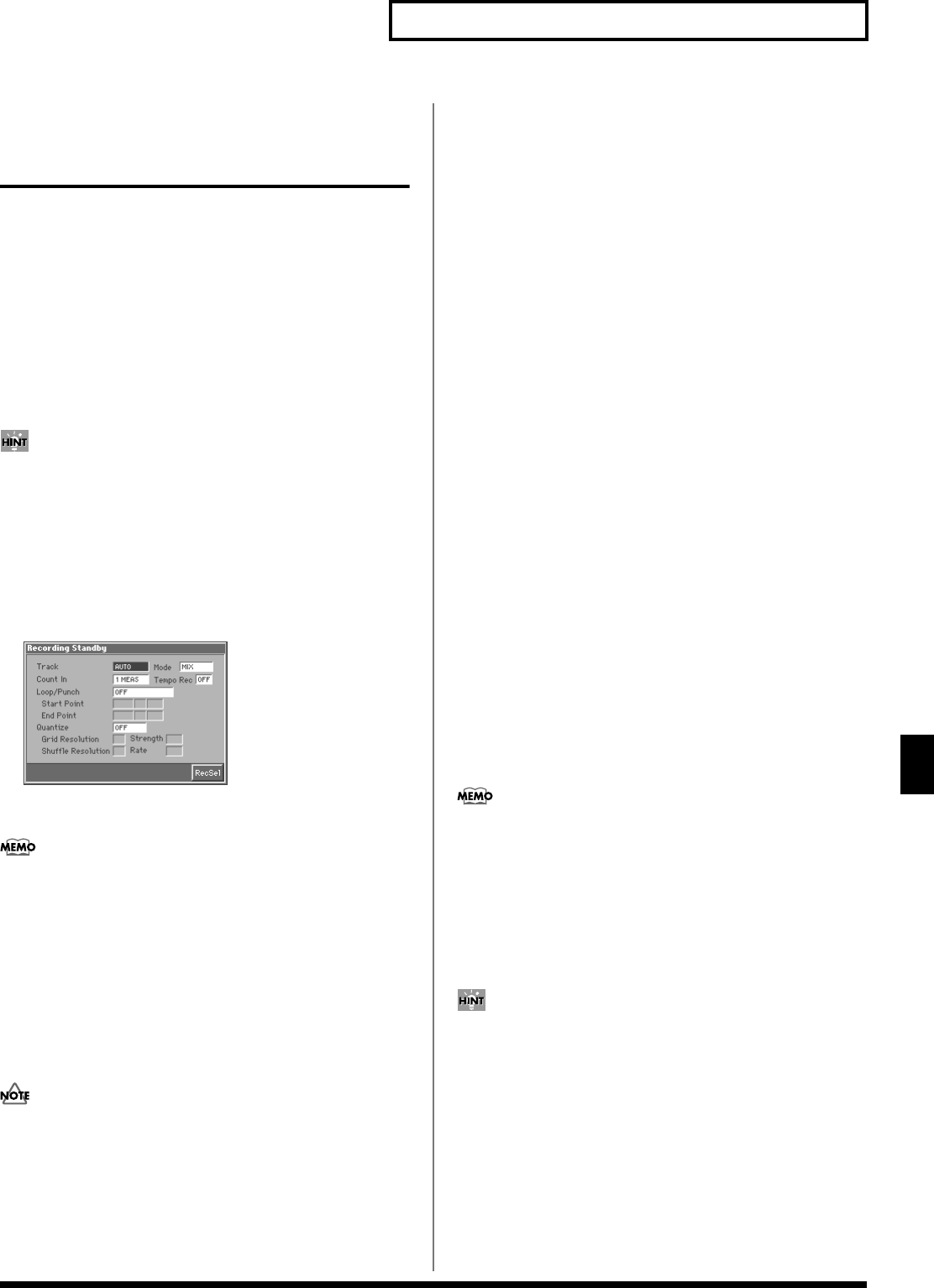
129
Recording Songs
Recording Songs
Recording Your Performance
as You Play It
(Realtime Recording)
Realtime Recording is the recording method in which your keyboard
playing and controller operations are recorded just as you perform
them. Use this recording method when you want to capture the
nuances of your own performance.
Basic Operation for Realtime
Recording
1. Make sure that the preparations for recording have been
completed as described in “Before You Record a New Song”
(p. 127).
If you want to record into an existing song, load the desired song
into internal memory (p. 136). Then press [FWD] or [BWD] to
specify the measure at which you want to begin recording. The
measure at which recording will begin is indicated by the “M=”
in the upper part of each PLAY screen.
2. Press [REC].
The [REC] indicator will blink, and the Recording Standby
window appears.
fig.07-11_50
This window lets you set various parameters for realtime
recording.
If you want to record a pattern, access the Pattern Edit screen (p.
139) and then press [REC].
3. As basic settings, specify the following three parameters.
Use [CURSOR] to move the cursor to each parameter, and
turn the VALUE dial or press [INC]/[DEC] to make the setting.
Track
Specify the phrase track or pattern on which you want to record.
Value: AUTO, TRK 1–TRK 16
PTN001–PTN100 (* when recording on a pattern)
“AUTO” can be selected only when recording in Multitimbre
mode. If you select “AUTO,” the part (current part) selected in
the MULTITIMBRE PLAY screen will automatically be specified
as the recording-destination phrase track.
Mode (Recording Mode)
Select how recording is to take place.
Value
MIX: Mix-recording will be carried out. Normally, you will record
using this method. If a performance has already been recorded on
the recording-destination track, your newly recorded performance
will be added to the existing performance without erasing it. By
using this in conjunction with Loop-recording, you can record
repeatedly over a specified area without erasing the previously
recorded performance. For example, this is a convenient way to
record a drum performance one instrument at a time; bass drum →
snare drum → hi-hat, etc.
REPLACE: Replace-recording will be carried out. If a performance
has already been recorded on the recording-destination track, it will
be erased as you record your new performance. Use this when you
want to re-record.
Count In
Select how recording is to begin.
Value
OFF: Recording will begin immediately when you press [STOP/
PLAY].
1 MEAS: When you press [STOP/PLAY], a count (playback) will
begin one measure before the recording-start location, and recording
will begin when you reach the recording-start location.
2 MEAS: When you press [STOP/PLAY], a count (playback) will
begin two measures before the recording-start location, and
recording will begin when you reach the recording-start location.
WAIT NOTE: Recording will begin when you play the keyboard or
press the Hold pedal.
4. When you are finished making settings in the Recording
Standby window, press [STOP/PLAY].
When recording begins, the Realtime Recording window will
appear. In this window, you can specify the Punch-in/out points
(p. 130), perform Realtime Erase (p. 132), and use the Rehearsal
function (p. 132). For details on these operations, refer to the
corresponding reference page. To close this window, press
[REC].
5. When you are finished recording, press [STOP/PLAY].
The [REC] indicator will go dark.
If you are not satisfied with the realtime recording you just
made, you can press [MENU], and from the Menu window that
appears, select “Undo Realtime Recording” to return to the state
prior to recording (Undo).
